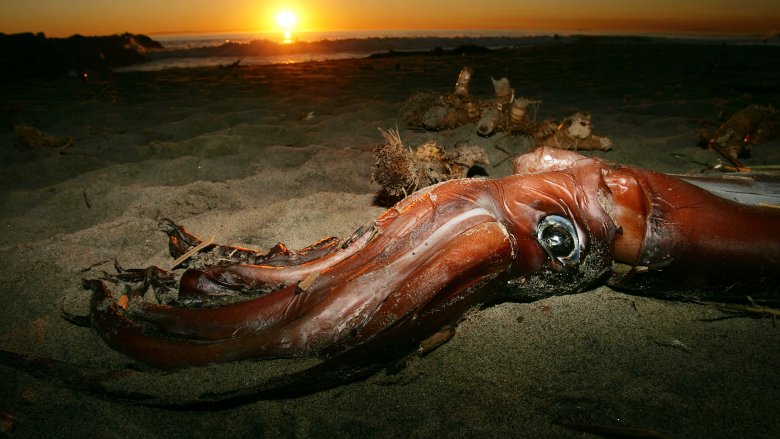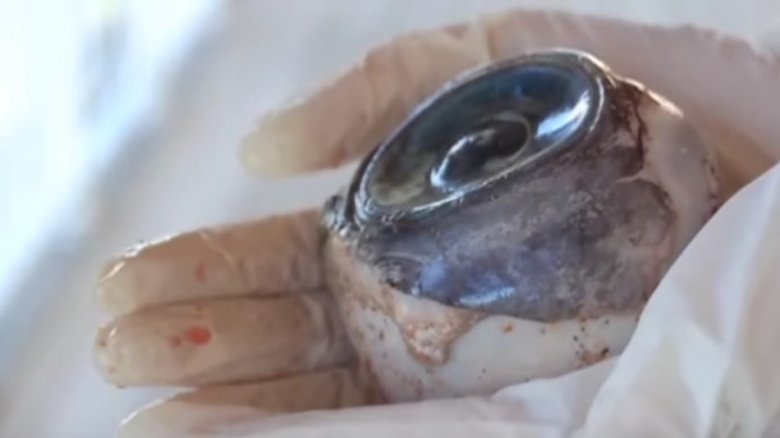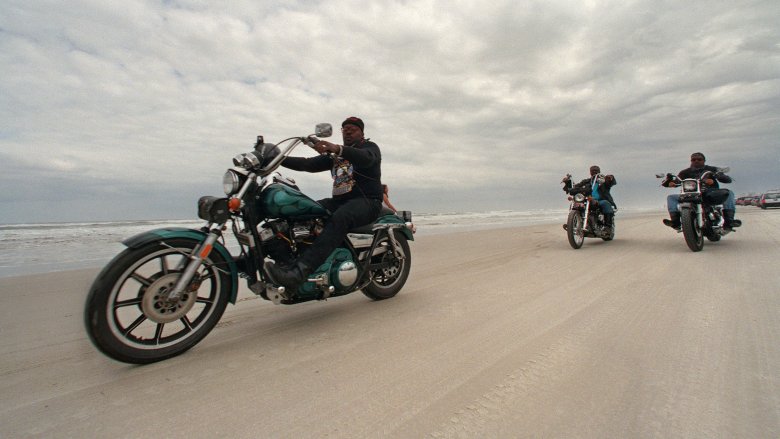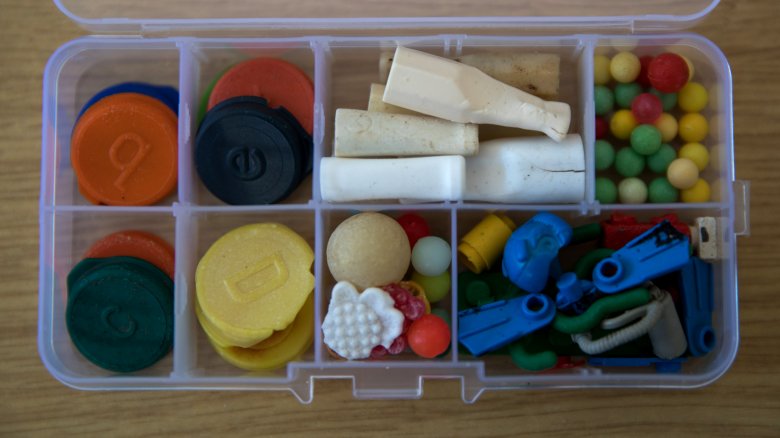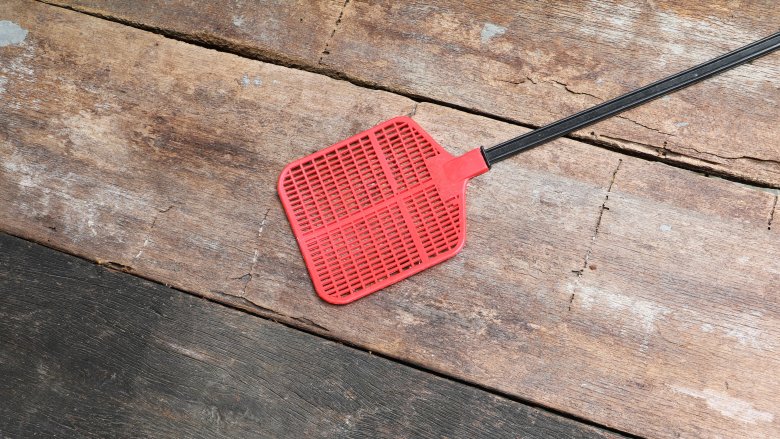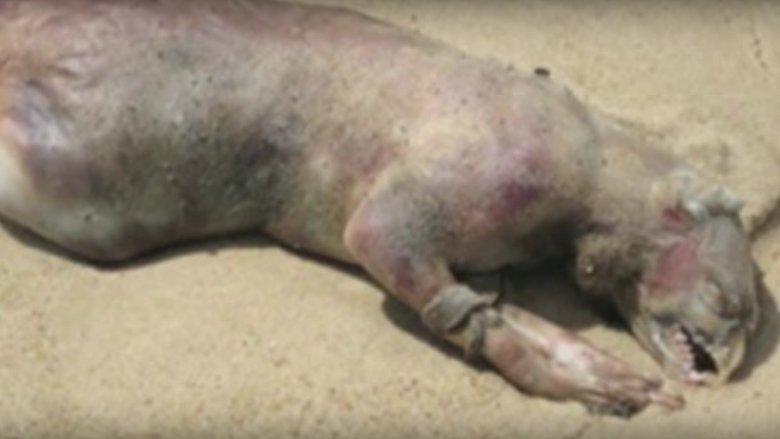Craziest Things That Ever Washed Up On A Beach
Ah, the beach — such a glorious place. Though it's perfect for sunbathing, building sandcastles, and (duh) long walks, it's also an excellent place to bust out your metal detector and search for treasures of the sea. Those treasures are usually cigarette butts, plastic litter, and aluminum cans. Sometimes, though, beach-combing turns up some unexpected surprises.
Human feet
Between 2007 and 2016, 16 human feet washed up on the beaches of the Pacific Northwest United States, most of them in British Columbia. For area residents and anyone at all interested in the serial occurrence of severed feet, this is probably a lot to handle.
While bizarre, nobody really knows what's going on with these lone appendages, which all have washed up within roughly 125 miles of each other. Vancouver City Coroner Stephen Fonseca told the Daily Beast he examined the feet but found no signs of "mechanical disarticulation" — meaning everyone can cross off the possibility that a serial murderer hacked off the feet. Rather, they probably decomposed from their host bodies naturally. Importantly, that doesn't rule out the serial killer scenario, but foul play of any kind seems unlikely.
Each severed foot examined has been unrelated to the others, meaning there are all sorts of reasons why these bodies could have ended up in the water. The Washington Post reported in 2016 that several of the feet had been identified or linked to their probable owners, and none of the scenarios were suspicious. Whatever's happening, pick seashells gingerly in Vancouver.
Hundreds of giant squid
Not only do replicas of famous aliens wash up on the beach, but real-life marine biology — some of which totally looks extra-terrestrial — also find its way ashore.
In September 2011, hundreds of squid carcasses — some as heavy as 20 pounds — invaded some California beaches. Naturally, some beach-goers were more than a little put off. Others saw the perfect opportunity. Local fishermen were stoked that the big wrigglers were swimming so close to shore, with one expedition of 40 people netting 990 of the jumbo squid, which aren't normally such an easy catch because they tend to stick to deeper waters.
So what were the hundreds of squid carcasses doing on the beach, exactly? Was it a signal of the end times rapidly approaching? According to the Orange County Register, a local game warden said the creatures most likely died after spawning. Natural! Still rare, but natural. And also a little sad, if you think about it.
A giant Lego man
In October 2008, a Lego man washed up on a Florida beach. But this one was a fiberglass giant, weighing 100 pounds and standing 8 feet tall, and was promptly taken into custody by Sarasota County's finest. As much as Lego would've liked to take credit for the weirdness, it was the work of artist Ego Leonard, who claims to come from a world "all green and blossoming, with no rules or limitations." You do you, Lego artist.
The Lego man is a world traveler. He's popped up in the Netherlands and England, in addition to L.A. County's Topanga Beach — where, unlike in Florida, he wasn't arrested. Instead, LA Weekly reported that Californians just chilled with the big yellow dude in the "NO REAL THAN YOU ARE" shirt, taking photos and hanging out — a reaction that should surprise no one familiar with West Coast chill.
A giant eyeball
Florida has seen more than its fair share of strangeness over the years, but 2012 saw something pretty odd wash up on one of the Sunshine State's beaches.
Pompano Beach resident Gino Covacci was surprised to find an over-sized eyeball about the size of a softball while taking a stroll along the shore. Realizing the eye was still fresh and bleeding, Covacci wisely popped that bad boy in a plastic bag and stuck it in the fridge, buying himself time to dig up giant eyeball experts. When he found them, those experts agreed the eyeball most likely came from a swordfish and was probably cut out by a fisherman's knife based on the markings. And here we were hoping we finally had evidence of Atlantis.
A Harley Davidson
Beachcombers are generally accustomed to finding interesting things. However, it's highly unlikely any seasoned beachcomber ever stumbled upon what Peter Mark found on British Columbia's Haida Gwaii islands.
Riding his ATV one morning — April 18, 2012, to be exact — Mark drove up on a giant white cube with a motorcycle tire sticking out of it. Upon further investigation, the Graham Island beachcomber discovered a fully intact Harley Davidson motorcycle inside. Mark realized upon closer inspection that the rusted licence plate was Japanese, as were the tags along the wall of the trailer. He correctly surmised that the expensive motorcycle probably found its way to the remote island after the 2011 Japanese tsunami.
It goes without saying that such a find is extremely rare, as most large items washed away from the Japanese tsunami likely have sunk to the bottom of the ocean, according to a Japanese government official in Vancouver. Mark did the right thing and contacted the appropriate authorities because he seems to be a decent human who can think of others. Right on.
Millions of Legos
If there's one thing you need to know about Cornwall, the southwestern tip of England, it's that its beaches are magnets for Lego pieces.
In 1997, a container fell off a cargo ship on the coast of Cornwall. This container was loaded with millions of plastic Lego pieces, and they've been steadily making their way to Cornish beaches ever since. The captain of the ship in question told the BBC the ship was ravaged by a "once in a 100-year" wave on February 13, 1997, that picked the ship clean, in the process claiming 4.8 million Lego pieces meant for New York.
Collecting the predominantly nautical-themed Lego pieces has become more than just a hobby to Cornish beachcombers. Some pieces, such as the green dragon or the octopus, are ultra-rare, meaning kids and adults alike make it a competition to snag the best pieces. If you're interested in joining in on the fun, check out the Facebook group and head to Cornwall yourself. If you're in Florida, some of the Lego pieces might make their way to your beaches, according to one oceanographer, but no one really knows where exactly the floating Legos will go. They could have circled the globe by now, or they could be sailing the seven seas for centuries to come.
World War II love letters
Quick, try to think of something that could potentially wash up on the beach and bring more tears to your eyes than lost World War II love letters. Good luck!
Like something out of a Nicholas Sparks movie, a ribbon-tied bundle of 57 love letters washed up the shore of Sandy Hook Bay, New Jersey. According to WNBC in New York, the letters were found by a 14-year-old boy in 2012 after Hurricane Sandy charged its way through. They were more than a little drenched, given the hurricane. The letters were dated from 1942 to 1948 and were apparently sweet enough to have you buzzing for days — or rot your teeth, depending on whether or not you're into that kind of sappy stuff.
To make the entire story even sweeter, the family quickly connected the letters to one Dorothy Fallon Farnham, then 91, who was living in New Jersey. The letters were mailed back to her right away, considering that's what anyone with a heart would do.
E.T.
E.T.'s journey — riding flying bicycles, dressing up as a woman, and freaking everybody out by turning white and lying abandoned in a creek — is well known by cinephiles the world over. What many don't know, however, is that the extra terrestrial once was kidnapped before being found waterlogged near a beach by Old Portsmouth, Hants.
Long story short, the daughter of a woman named Margaret Wells hand-crafted a replica of Steven Spielberg's famous alien, which was stolen — along with various other things — in September 2011, according to The Telegraph. A few months later, one strolling civilian happened to see a body floating in the water and did what any upstanding citizen would do and called 999 (911 for Brits). Instead of a human body, first responders were surprised to find an alien wearing a massive grin and missing a finger.
Forget about merely phoning home. This E.T. took it upon himself to channel his inner dolphin and swim his way home, earning an A for effort and surely shedding a few pounds off that little beer belly.
Thousands of Nike shoes
Looking to score a free pair of Nike kicks? Maybe you just need to head to the beach. Back in 1990, some 80,000 pairs of Nike shoes decided they were just gonna do it and jumped off a cargo ship into the mighty Pacific Ocean, according to National Geographic. Many ended up on beaches around the world and rewarded beachcombers with soggy — but technically never-before-worn — sneakers. And this wasn't a lone occurrence. Nike shoes have proven hard to contain on multiple occasions.
"Lucky" Washington and Oregon beachgoers were able to snag 1999 Nike Cross Trainers in 2001, after another cargo ship had a run-in with a hurricane, which liberated the ship of two shipping containers of Nikes and some other cargo. In 2003, "enough soggy Nike basketball shoes to outfit every high school team in [Alaska]" took a tumble off a boat near Northern California, according to the Associated Press. It seems some Nike shoes get dosed with a little too much kick before leaving the factory.
Rubber duckies
In 1992, NPR reported that some 28,000 rubber duckies got the ride of their little lives, objectively way more fun than any bathtub could be. The bath toys sailed the high seas as a squad after the shipping container they were in took a swan dive off the side of a cargo ship. Naturally, the rubber duckies eventually found their way to shore — though not all at the same place.
Some of the duckies spent more than a decade surfing the ocean's waves, eventually landing on the opposite side of the globe from their bathtime brethren. Some ducks ended up in Europe, while some ended up in Hawaii. Others made landfall all the way up in Alaska. Over a ten-year span, the family of ducks really got around, spreading out and blazing their own trails — which, in turn, has helped oceanographers better understand how floating ocean debris travels.
If you ever happen to find a rubber duck on the beach, go ahead and grab it. It may just have come from the famous spill. Just don't put it in your mouth. It might have harmful chemicals in it, and besides, it's probably pretty dirty after decades on the high seas.
Sports-themed fly swatters
Alaskan sports fans and haters of pesky flies had a field day back in 2012 when loads of collegiate and professional sports-themed fly swatters made their way to one of the state's island beaches.
By this point, you've probably guessed that they fell off a ship, and you're correct. One cargo ship reportedly lost a container of Team Sports America fly swatters after a rogue wave took it upon itself to proverbially punch the ship right in its proverbial beak, sending the proverbial weapons of mass fly destruction straight out into the open ocean.
Sports-themed fly swatters might not be the most desirable sports mementos, but what they lack in style, they more than make up for in functionality. This random act of oceanic violence must have been particularly fortuitous for those who found the swatters, as black flies can be ultra pesky up in Alaska — so we're just gonna chalk this one up to fate.
The Montauk Monster
One of 2008's top stories — depending on how you rank your news — was that of a sea monster that washed up on a Long Island beach in the East Hamptons.
In July 2008, a woman happened across some sort of beached monstrosity. The creature in question appeared to be a strange conglomeration of animal parts and was quickly named the Montauk Monster. It lit the internet on fire — at least, for a little while. (Going viral with a creepy photo was a little easier back in the day.)
As fate would have it, the Montauk Monster wasn't really a monster at all — it was just a decomposing raccoon with a rotting face, according to the experts. Hey, life is full of disappointments.


